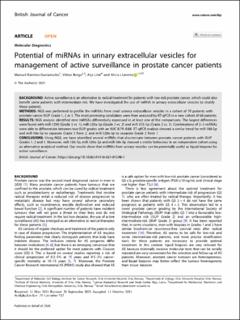| dc.contributor.author | Ramirez-Garrastacho, Manuel | |
| dc.contributor.author | Berge, Viktor | |
| dc.contributor.author | Linē, Aija | |
| dc.contributor.author | Llorente, Alicia | |
| dc.date.accessioned | 2022-02-23T12:54:10Z | |
| dc.date.available | 2022-02-23T12:54:10Z | |
| dc.date.created | 2021-12-02T14:04:25Z | |
| dc.date.issued | 2021-11-22 | |
| dc.identifier.citation | British Journal of Cancer. 2021, . | en_US |
| dc.identifier.issn | 0007-0920 | |
| dc.identifier.issn | 1532-1827 | |
| dc.identifier.uri | https://hdl.handle.net/11250/2981024 | |
| dc.description.abstract | Background: Active surveillance is an alternative to radical treatment for patients with low-risk prostate cancer, which could also benefit some patients with intermediate risk. We have investigated the use of miRNA in urinary extracellular vesicles to stratify these patients.
Methods: NGS was performed to profile the miRNAs from small urinary extracellular vesicles in a cohort of 70 patients with prostate cancer ISUP Grade 1, 2 or 3. The most promising candidates were then analysed by RT-qPCR in a new cohort of 60 patients.
Results: NGS analysis identified nine miRNAs differentially expressed in at least one of the comparisons. The largest differences were found with miR-1290 (Grade 3 vs. 1), miR-320a-3p (Grade 3 vs. 2) and miR-155-5p (Grade 2 vs. 1). Combinations of 2–3 miRNAs were able to differentiate between two ISUP grades with an AUC 0.79–0.88. RT-qPCR analysis showed a similar trend for miR-186-5p and miR-30e-5p to separate Grade 3 from 2, and miR-320a-3p to separate Grade 2 from 1.
Conclusions: Using NGS, we have identified several miRNAs that discriminate between prostate cancer patients with ISUP Grades 1, 2 and 3. Moreover, miR-186-5p, miR-320a-3p and miR-30e-5p showed a similar behaviour in an independent cohort using an alternative analytical method. Our results show that miRNAs from urinary vesicles can be potentially useful as liquid biopsies for active surveillance. | en_US |
| dc.description.sponsorship | This work was supported by the TRANSCAN2-JTC2016 call (Project PROSCANEXO), The South-Eastern Norwegian Regional Health Authority, The Norwegian Cancer Society and The Research Council of Norway. | en_US |
| dc.language.iso | eng | en_US |
| dc.publisher | Springer Nature | en_US |
| dc.relation.ispartofseries | British Journal of Cancer;126 (2022) | |
| dc.rights | Navngivelse 4.0 Internasjonal | * |
| dc.rights.uri | http://creativecommons.org/licenses/by/4.0/deed.no | * |
| dc.subject | Biomarkers | en_US |
| dc.subject | Prostate cancer | en_US |
| dc.title | Potential of miRNAs in urinary extracellular vesicles for management of active surveillance in prostate cancer patients | en_US |
| dc.type | Peer reviewed | en_US |
| dc.type | Journal article | en_US |
| dc.description.version | publishedVersion | en_US |
| dc.rights.holder | © The Author(s) 2021 | en_US |
| cristin.ispublished | true | |
| cristin.fulltext | original | |
| cristin.qualitycode | 2 | |
| dc.identifier.doi | https://doi.org/10.1038/s41416-021-01598-1 | |
| dc.identifier.cristin | 1963484 | |
| dc.source.journal | British Journal of Cancer | en_US |
| dc.source.pagenumber | 1-10 | en_US |

